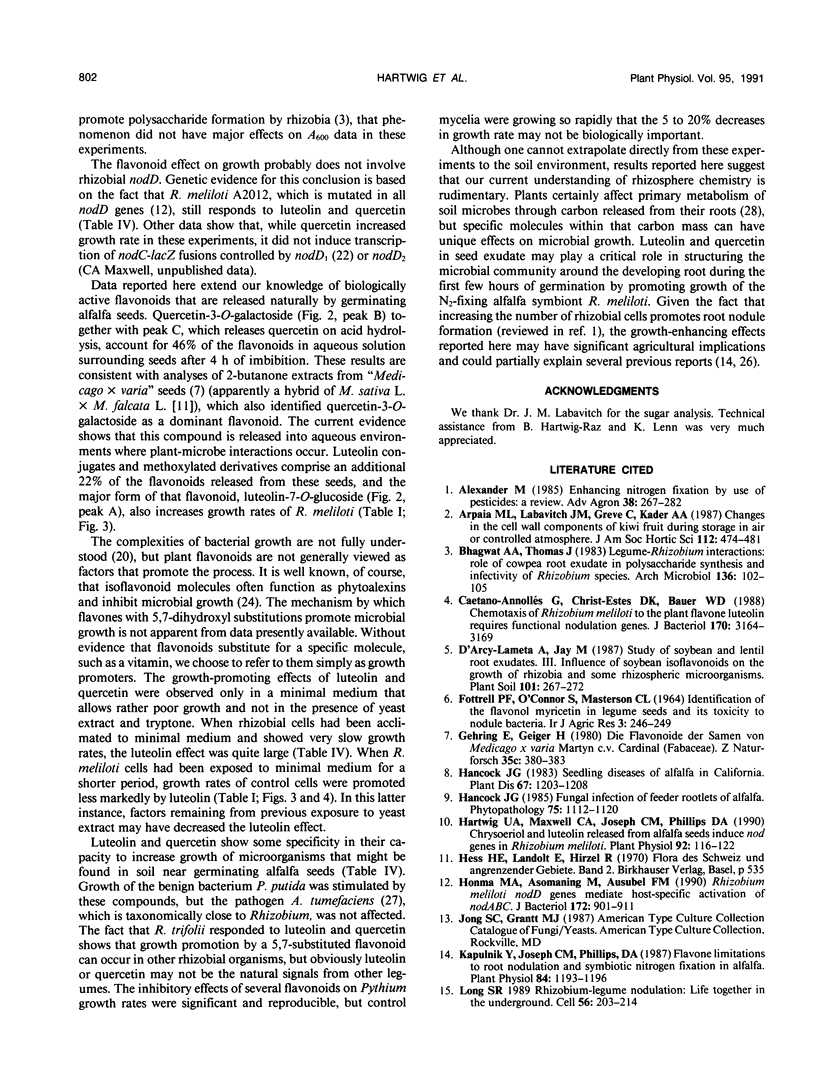Abstract
Alfalfa (Medicago sativa L.) releases different flavonoids from seeds and roots. Imbibing seeds discharge 3′,4′,5,7-substituted flavonoids; roots exude 5-deoxy molecules. Many, but not all, of these flavonoids induce nodulation (nod) genes in Rhizobium meliloti. The dominant flavonoid released from alfalfa seeds is identified here as quercetin-3-O-galactoside, a molecule that does not induce nod genes. Low concentrations (1-10 micromolar) of this compound, as well as luteolin-7-O-glucoside, another major flavonoid released from germinating seeds, and the aglycones, quercetin and luteolin, increase growth rate of R. meliloti in a defined minimal medium. Tests show that the 5,7-dihydroxyl substitution pattern on those molecules was primarily responsible for the growth effect, thus explaining how 5-deoxy flavonoids in root exudates fail to enhance growth of R. meliloti. Luteolin increases growth by a mechanism separate from its capacity to induce rhizobial nod genes, because it still enhanced growth rate of R. meliloti lacking functional copies of the three known nodD genes. Quercetin and luteolin also increased growth rate of Pseudomonas putida. They had no effect on growth rate of Bacillus subtilis or Agrobacterium tumefaciens, but they slowed growth of two fungal pathogens of alfalfa. These results suggest that alfalfa can create ecochemical zones for controlling soil microbes by releasing structurally different flavonoids from seeds and roots.
Full text
PDF






Selected References
These references are in PubMed. This may not be the complete list of references from this article.
- Caetano-Anollés G., Crist-Estes D. K., Bauer W. D. Chemotaxis of Rhizobium meliloti to the plant flavone luteolin requires functional nodulation genes. J Bacteriol. 1988 Jul;170(7):3164–3169. doi: 10.1128/jb.170.7.3164-3169.1988. [DOI] [PMC free article] [PubMed] [Google Scholar]
- Hartwig U. A., Maxwell C. A., Joseph C. M., Phillips D. A. Chrysoeriol and Luteolin Released from Alfalfa Seeds Induce nod Genes in Rhizobium meliloti. Plant Physiol. 1990 Jan;92(1):116–122. doi: 10.1104/pp.92.1.116. [DOI] [PMC free article] [PubMed] [Google Scholar]
- Honma M. A., Asomaning M., Ausubel F. M. Rhizobium meliloti nodD genes mediate host-specific activation of nodABC. J Bacteriol. 1990 Feb;172(2):901–911. doi: 10.1128/jb.172.2.901-911.1990. [DOI] [PMC free article] [PubMed] [Google Scholar]
- Kapulnik Y., Joseph C. M., Phillips D. A. Flavone limitations to root nodulation and symbiotic nitrogen fixation in alfalfa. Plant Physiol. 1987 Aug;84(4):1193–1196. doi: 10.1104/pp.84.4.1193. [DOI] [PMC free article] [PubMed] [Google Scholar]
- Long S. R. Rhizobium-legume nodulation: life together in the underground. Cell. 1989 Jan 27;56(2):203–214. doi: 10.1016/0092-8674(89)90893-3. [DOI] [PubMed] [Google Scholar]
- Maxwell C. A., Hartwig U. A., Joseph C. M., Phillips D. A. A Chalcone and Two Related Flavonoids Released from Alfalfa Roots Induce nod Genes of Rhizobium meliloti. Plant Physiol. 1989 Nov;91(3):842–847. doi: 10.1104/pp.91.3.842. [DOI] [PMC free article] [PubMed] [Google Scholar]
- Maxwell C. A., Phillips D. A. Concurrent Synthesis and Release of nod-Gene-Inducing Flavonoids from Alfalfa Roots. Plant Physiol. 1990 Aug;93(4):1552–1558. doi: 10.1104/pp.93.4.1552. [DOI] [PMC free article] [PubMed] [Google Scholar]
- Meade H. M., Long S. R., Ruvkun G. B., Brown S. E., Ausubel F. M. Physical and genetic characterization of symbiotic and auxotrophic mutants of Rhizobium meliloti induced by transposon Tn5 mutagenesis. J Bacteriol. 1982 Jan;149(1):114–122. doi: 10.1128/jb.149.1.114-122.1982. [DOI] [PMC free article] [PubMed] [Google Scholar]
- Peters N. K., Frost J. W., Long S. R. A plant flavone, luteolin, induces expression of Rhizobium meliloti nodulation genes. Science. 1986 Aug 29;233(4767):977–980. doi: 10.1126/science.3738520. [DOI] [PubMed] [Google Scholar]
- Peters N. K., Long S. R. Alfalfa Root Exudates and Compounds which Promote or Inhibit Induction of Rhizobium meliloti Nodulation Genes. Plant Physiol. 1988 Oct;88(2):396–400. doi: 10.1104/pp.88.2.396. [DOI] [PMC free article] [PubMed] [Google Scholar]
- THOMPSON J. A. Inhibition of nodule bacteria by an antibiotic from legume seed coats. Nature. 1960 Aug 13;187:619–620. doi: 10.1038/187619a0. [DOI] [PubMed] [Google Scholar]
- VALERA C. L., ALEXANDER M. NODULATION FACTOR FOR RHIZOBIUM-LEGUME SYMBIOSIS. J Bacteriol. 1965 Apr;89:1134–1139. doi: 10.1128/jb.89.4.1134-1139.1965. [DOI] [PMC free article] [PubMed] [Google Scholar]
- Watson B., Currier T. C., Gordon M. P., Chilton M. D., Nester E. W. Plasmid required for virulence of Agrobacterium tumefaciens. J Bacteriol. 1975 Jul;123(1):255–264. doi: 10.1128/jb.123.1.255-264.1975. [DOI] [PMC free article] [PubMed] [Google Scholar]


